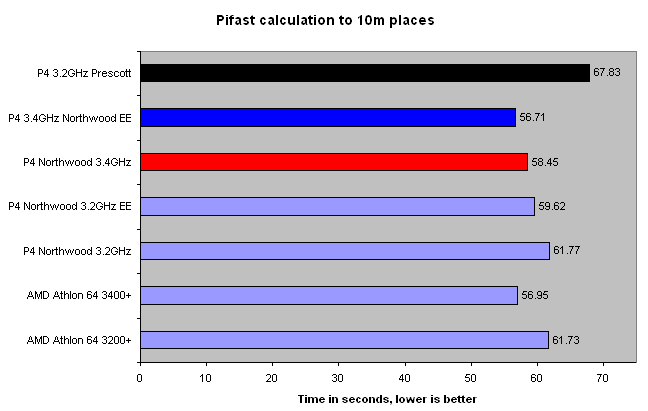ScienceMark 2.0, Pifast
A preface to the benchmarks. The most important comparison should be made between the 3.2GHz Prescott, 3.2GHz Northwood and AMD's Model 3200+ and 3400+ CPUs. Intel's Extreme Edition chips are limited in supply and horrendously expensive. The 3.4GHz Northwood will be priced at a healthy premium over the 3.2GHz models. Our online investigation has revealed retail Prescott 3.2GHz CPUs available on pre-order for £270 including VAT. That's current 3.2GHz Northwood and just below AMD Athlon 64 3400+ territory. The 3.4GHz Northwood Extreme Edition CPU will market on the wrong side of £500. It's designed for maximum performance. Value for money isn't a primary concern.Let's get the ball rolling with a look at memory bandwidth.

The benchmark graphs will continue in this fashion. The CPUs will be listed in the same order and benchmark results will be shown on the right. The listing is not based on high-to-low benchmark performance. ScienceMark 2.0 maintains that the Prescott CPU is better able to tap into the potential 6.4GB/s memory bandwidth that dual-channel DDR400 memory affords. The difference is marked, too. The Prescott uses a more refined prefetching and branch prediction unit, implemented to negate some of the performance loss incurred by a 31-stage pipeline. ScienceMark 2.0 seems to take that into account. The other four Pentium 4 chips produce similar performance. One would assume that, they're all Northwoods at heart. AMD's single-channel CPUs aren't basking in glory here. What about latency ?.

Pretty similar for all Pentium 4s, with each hovering around the 80ns mark. The Prescott can be thought of as a modified Pentium 4. It's pretty similar underneath. The Extreme Edition and regular 3.4GHz Northwoods' performance attributes are tested here. They will be in memory-related and cache-dependant benchmarks a little later on. Athlon 64 CPUs have an on-die memory controller which does a fine job of reducing latency. One of the CPUs' strengths.
All of our discussion pertaining to the Prescott and faster Northwoods may not prepare you for the next graph. The results, however, were repeatable. Our first practical test is usually Pifast, the constant calculator that thrives on memory bandwidth and, to some extent, a larger cache.

We spent time explaining how and why a longer pipeline might severely hurt performance. Here's the physical manifestation of those thoughts and musings. The Prescott's 1MB L1 cache, 16kb L1 data cache and other optimisations cannot overcome the performance hurdle that a 31-stage pipeline inevitably creates. Put simply, the newer Pentium 4 is doing far less work per clock cycle than the Northwood, which is already a CPU that's been criticised for a low work-per-clock-cycle output. The Prescott 3.2GHz CPU is 10% slower than the equivalent Northwood, and far, far slower than the Athlon 64 3400+.
The 3.4GHz Northwoods, and in particular the Extreme Edition, just lap this benchmark up. The 3.4GHz EE produces the fastest stock time yet seen at HEXUS. That's Northwood power used to the fullest, ably supported by 2MB of on-chip cache. In case you've missed it, the Prescott is slower than the equivalent clocked Northwood in Pifast. That says it all.









